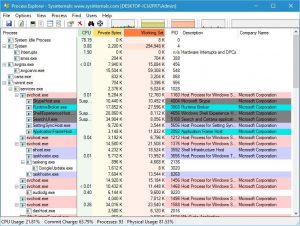
- Sysinternals process monitor show ram usage install#
- Sysinternals process monitor show ram usage password#
- Sysinternals process monitor show ram usage license#
- Sysinternals process monitor show ram usage series#
- Sysinternals process monitor show ram usage windows#
The first tip is to disable any activity that you don’t want to capture or are not required for the issue that you are troubleshooting. This prompted me to think about capturing data with Process Monitor and some things I learnt along way while using this tool working at CSS. I recently wrote about importing a Process Monitor trace into SQL Server database table and crunch up the data to extract the events and call stacks. Use the options mentioned in Tools Tips and Tricks #1: Process Monitor so that the filters are correctly set and the page file doesn’t get overwhelmed if you are capturing data for long periods or on servers where there is high amount of activity. Or you could alternatively create a configuration file and use the /LoadConfig command line switch for Process Monitor.Īgain the possibilities are endless and you can extend this by using the command line options for PsExec and Process Monitor. After that Exit Process Monitor and run the above command from Command Line. If you need to set filters for Process Monitor, then run the Process Monitor tool in GUI mode and set the Filters and save it. This utility takes a parameter for milli-seconds to wait.
Sysinternals process monitor show ram usage windows#
If you do not prefer the ping method to simulate waits, you can use the SLEEP utility available with Windows 2003 Resource Kit. The command that I used to execute the commands present in the. The reason why we would have to run Process Monitor from command line is because while running setup, it’s recommended that you do not log into the passive nodes using Terminal Services or Console Mode. cmd file to spawn Process Monitor on a different server and capture a trace using a local file as the backing file. Start %PM% /quiet /minimized /AcceptEULA /backingfile D:\ProcMon\notepad.pml cmd file that I am using in this case has the following commands: This is quite useful if you need to collect a Process Monitor trace from one of the passive nodes while running SQL Server 2005 setup.

The scenario that I will discuss today is collection of a Process Monitor trace on a server without logging onto the machine.
Sysinternals process monitor show ram usage install#
PsExec lets you execute processes on other systems without having to manually install client software. Today I shall talk about using PsExec (part of the PsTools package) to collect data from a remote box through PsExec.
Sysinternals process monitor show ram usage series#
Windows Task Manager - List of running process IDs (PID)Įquivalent PowerShell: Get-Process - Get a list of processes on a machine (ps/gps)Įquivalent bash command (Linux): ps - Process status, information about processes running in memory.A new week begins and the Tools, Tips and Tricks series continues. TASKLIST - List running applications and services. ProcDump - Monitor an application for CPU spikes. OPENFILES - Query or display open files, disconnect files opened by network users. PsKill - Kill processes by name or process ID. Never practice two vices at once” ~ Tallulah Bankhead List all processes running on \\workstation64:Ĭ:\> SC \\workstation64 start RemoteRegistry Set-ItemProperty -Path 'Registry::HKEY_CURRENT_USER\Software\Sysinternals' -Name 'EulaAccepted' -Value 1
Sysinternals process monitor show ram usage license#
You can avoid this by writing the license registry key:

When launched for the first time, PsList will prompt you to accept the EULA. When running PsList against a remote system you must have administrative rights on that system, and the system must be running the Remote Registry service. The default information listed includes the time the process has executed, the amount of time the process has executed in kernel and user modes, and the amount of physical memory that the OS has assigned the process. ? Display options and units of measurement. accepteula Suppress the display of the license dialog. Will display processes that start with exp. Name Scan only those processes that begin with the name process. x Show CPU, memory and thread information for each process specified. Rather than the default of CPU-oriented information. m Show memory-oriented information for each process, t Show statistics for all active threads on the system,Įach thread is grouped with its owning process. u user Specify a user name for login to remote computer(optional). If omitted, you will be prompted to enter a hidden password.
Sysinternals process monitor show ram usage password#
p passwd Specify a password for user (optional). Pslist ] Ĭomputer The computer on which the process is running. Process Status, list information about processes running in memory.


 0 kommentar(er)
0 kommentar(er)
